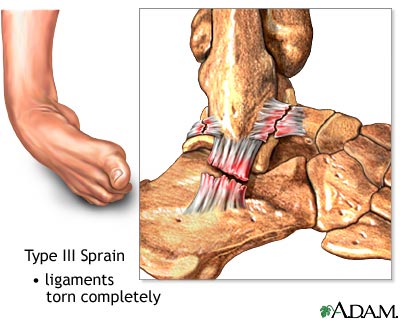Ankle Sprains
Ankle Sprains : Get Back On Your Feet
Ankle sprains are one of the most common injuries in sport, accounting for an estimated one in 10 injuries in players of all ages. Most ankle sprains occur during the latter third of practice or competition and can be the result of player-to-player contact, or landing, twisting, cutting and running on uneven surfaces. Some ankle sprains occur when athletes are horsing around or equipment where it doesn't belong.
Injury
A sprain happens when the ankle turns in or out, causing a stretch or tear to one or more ligaments that connect the bones of the ankle joint. Most ankle sprains occur on the outside of the ankle. Players might feel a “pop” when they sprain the ankle, like the snapping of a tight rubber band. This is the ligaments tearing or stretching. Pain and swelling usually happen right away. There may be bruising around the ankle and the foot. Athletes may not be able to move the ankle as usual or put weight on it.
Early Treatment: 24 to 48 hours
Reducing the swelling is an important part of early treatment. It helps to decrease pain and speed healing.
· Keep the ankle raised above the heart as much as possible.
· Wrap the ankle with an elastic bandage.
· Put a bag of ice or frozen vegetables on the ankle for 20 to 30 minutes every one to two hours.
· Use crutches until the athlete can walk without pain.
After 48 Hours
Step One
The sooner athletes get their ankle moving, the sooner they will get back to the game. As the swelling goes down, the ankle will move more easily. Use these exercises to increase ankle movement:
·“Alphabet” exercise: Draw each letter of the alphabet in the air, using the big toe as the “pencil.” Perform one time; repeat throughout the day.
· Motion exercise: Move the ankle up and down in a straight line as far as it will go 10 to 15 times. Do this several times per day.
Continue to ice the ankle as much as possible or as time allows. As long as swelling continues, keep the ankle elevated as often as possible.
Step Two
Calf muscles get tighter and weaker after an ankle sprain. Once the swelling goes down and players can move the ankle more, they should begin to stretch and strengthen the muscles around the ankle. Put ice on the ankle if it begins to swell or hurt after doing these exercises.
· Muscle stretch: Face the wall, standing about two to three feet away. Place hands on the wall, heels on the ground. Keep the knee straight (not locked). Lean toward the wall. Hold for 30 seconds. Repeat 10 times. Repeat the stretch, but bend the knee.
· Muscle strengthening (Toe raises): Rock back on the heels of both feet. Repeat 10 to 20 times.
· Muscle strengthening (Heel raises): Rise up on the toes of both feet, trying not to roll in or out on the toes. Repeat 10 to 20 times.
Sports Conditioning
Balance
When an athlete sprains the ankle, some balance is lost. To regain it, stand on the injured ankle and balance for 30 seconds, increasing to three minutes. Repeat with the eyes closed, then balance on the other leg. Be sure the athlete has a wall or chair nearby for support. Repeat three times daily.
Running
Begin light jogging when the athlete can walk without limping or pain. Jog on a flat, even surface for about 10 minutes and gradually increase the time each day. Do not increase the time if the athlete has more pain and swelling. Ice the ankle for 20 minutes after jogging. Wear an ankle brace for extra support if recommended by a sports medicine doctor.
Sport Skills
Many sports require quick changes in direction so sometimes the ankle needs to be “re-educated” to do this. Perform these exercises in order:
· Sprints: Do 40-yard sprints at 1/2 speed, then 3/4 speed, then full speed.
· Figure eights: Run zigzags in a figure-eight pattern of 5-yard circles.
· Zigzags: Run a zigzag pattern, changing directions every 5 yards.
When athletes can do all these exercises without increased pain or swelling, they are ready to return safely to the game.
Warning Signs to Seek Help
If the athletes can't stand on the ankle, see a sports medicine doctor to determine the extent of the injury. Contact a doctor if the athlete experiences any of the following:
· Numbness in the foot or ankle
· Increased swelling, rather than a gradual decrease
· Re-injury of the ankle
· A sensation that the ankle gives way while walking or running
